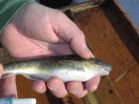(Press-News.org) Glaucoma – a leading cause of vision loss and blindness worldwide – runs in families. A team of investigators from Vanderbilt University and the University of Florida has identified a new candidate gene for the most common form of the eye disorder, primary open angle glaucoma (POAG).
The findings, reported Feb. 17 in the open-access journal PLoS Genetics, offer novel insights into glaucoma pathology and could lead to targeted treatment strategies.
Elevated pressure inside the eye is a strong risk factor for POAG. Pressure increases because of increased resistance to the flow of aqueous humor out of the eye's front chamber (between the cornea and iris). Current treatments for POAG attempt to reduce intraocular pressure by reducing aqueous humor production or by surgically providing a clear "drain."
"It has been known for decades that the reason the pressure goes up in POAG is because the outflow pathway for aqueous humor is not working," said Rachel Kuchtey, M.D., Ph.D., assistant professor of Ophthalmology and Visual Sciences and principal investigator of the current studies.
"It seems kind of simple – there's a decrease in the rate of aqueous humor flowing out of the eye," said John Kuchtey, Ph.D., research instructor in Ophthalmology and Visual Sciences and first author of the paper. "But the basic mechanisms of aqueous humor outflow at the cellular and molecular level – and how they are disrupted in glaucoma – are not understood. It's a long-standing puzzle in ophthalmology."
So far, three genes have been associated with human glaucoma, but they account for only a small fraction of cases and have not shed much light on the disease process. The Vanderbilt investigators turned to a model with simpler genetics – a canine model of the disease.
Forty years ago, Kirk Gelatt, V.M.D., from the UF College of Veterinary Medicine, came across a litter of beagles that had a high incidence of glaucoma. The finding suggested to Gelatt that the disease was inherited, and he established a colony of POAG-affected beagles to study treatments for the disease.
In affected beagles, intraocular pressure begins to increase at 8 to 16 months of age, due to increased resistance to aqueous humor outflow. The clinical course of the disease "absolutely resembles human glaucoma," Rachel Kuchtey said.
The beagles are the only naturally occurring animal model for human POAG.
The Vanderbilt investigators used blood samples to search for genes associated with POAG. They first narrowed in on a certain spot (locus) on canine chromosome 20, which matched part of human chromosome 19. Previous studies had associated the human region with intraocular pressure, a good sign that they were on the right track, John Kuchtey said.
Sequencing of the entire canine locus – over 4 million "letters" of DNA – revealed that a gene called ADAMTS10 was the strongest disease-associated candidate. POAG-affected dogs have a single mutation in the gene, which encodes a protein involved in processing the extracellular matrix (ECM), the connective and structural support tissue around cells.
"There is a lot of evidence that proteoglycans (molecules in the ECM) and matrix remodeling might have something to do with aqueous outflow resistance, and so this gene supports that line of investigation," John Kuchtey said.
The researchers also demonstrated that the gene is highly expressed in the trabecular meshwork – the specialized filtration tissue through which aqueous humor passes, another supportive piece of evidence that it may have a role in regulating aqueous humor outflow.
The investigators are currently exploring ADAMTS10's normal biological functions, and they have studies in progress to examine whether the human ADAMTS10 gene is mutated in human glaucoma. They are hopeful that understanding this gene will open therapeutic possibilities for glaucoma.
"Right now we know that aqueous outflow is impaired in POAG, but we have no way to fix it because we don't understand how that normally works and what the pathology is in POAG," Rachel Kuchtey said.
"If this gene truly plays a role in aqueous outflow regulation, we can begin to look at it – or its molecular partners – as targets for treatments."
Gene therapy to rescue a defect might also be a possibility. Gene therapy for an inherited form of childhood blindness was first validated in dogs and is now in trial in humans.
INFORMATION:
Rachel Kuchtey and John Kuchtey are members of the Vanderbilt Eye Institute. Their collaborators at Vanderbilt include Jonathan Haines, Ph.D., and Tina Iverson, Ph.D. The National Eye Institute and a number of foundation grants including the David K. Wilson Discovery Grant supported the research.
Identification of glaucoma gene brightens view for future therapies
2011-02-18
ELSE PRESS RELEASES FROM THIS DATE:
Checklist cuts lethal ventilator-associated lung infections
2011-02-18
Cases of ventilator-associated pneumonia — the most lethal and among the most common of all hospital-associated infections — dropped by more than 70 percent in Michigan hospitals where medical staff used a simple checklist designed by Johns Hopkins researchers. Such pneumonias kill an estimated 36,000 Americans each year.
The findings, published online in the journal Infection Control and Hospital Epidemiology, show how a relatively simple series of steps, coupled with an education program and a culture that promotes patient safety, can save tens of thousands of lives ...
New Pitt projects will test brain computer interfaces for people with spinal cord injury
2011-02-18
PITTSBURGH, Feb. 17 – Researchers at the University of Pittsburgh have been awarded funding for two projects that will place brain-computer interfaces (BCI) in patients with spinal cord injuries to test if it is possible for them to control external devices, such as a computer cursor or a prosthetic limb, with their thoughts.
The projects build upon ongoing research conducted in epilepsy patients who had the interfaces temporarily placed on their brains and were able to move cursors and play computer games, as well as in monkeys that through interfaces guided a robotic ...
A genetic mutation allows Hudson River fish to adapt to PCBs
2011-02-18
NEW YORK, Feb. 17, 2011 – A research group led by a New York University School of Medicine scientist discovered a genetic variant that allows a fish in the Hudson River to live in waters heavily polluted by PCBs. In a study published in the February 18, 2011, online issue of Science, they report that a population of Hudson River fish apparently evolved rapidly in response to the toxic chemicals, which were first introduced in 1929, and were banned fifty years later. PCBs, or polychlorinated biphenyls, were used in hundreds of industrial and commercial applications, especially ...
Turning forests into fuel: New report outlines promise and limits of biomass energy in the Northeast
2011-02-18
(Millbrook, N.Y. – Feb 17, 2011) Forest biomass could replace as much as one quarter of the liquid fossil fuel now being used for industrial and commercial heating in the Northeastern United States. That's according to a new report released today by the Cary Institute of Ecosystem Studies.
But the report also has sharp caveats: The potential for forest biomass varies widely within the region, and forest resources must be carefully managed to protect the other important services and goods they provide. Under the right circumstances, however, the report found that forest ...
Unraveling how prion proteins move alon axons in the brain
2011-02-18
Researchers at the University of California, San Diego School of Medicine have identified the motors that move non-infectious prion proteins (PrPC) – found within many mammalian cells – up and down long, neuronal transport pathways. Identifying normal movement mechanisms of PrPC may help researchers understand the spread of infectious prions within and between neurons to reach the brain, and aid in development of therapies to halt the transport.
Their study is published in the February 18 edition of the journal Cell.
The small prion protein is found in the cell membrane ...
Pollution triggers genetic resistance mechanism in a coastal fish
2011-02-18
For 30 years, two General Electric facilities released about 1.3 million pounds of polychlorinated biphenyls (PCBs) into New York's Hudson River, devastating and contaminating fish populations. Some 50 years later, one type of fish—the Atlantic tomcod—has not only survived but appears to be thriving in the hostile Hudson environment.
Researchers from Woods Hole Oceanographic Institution (WHOI) have joined colleagues from New York University (NYU) and NOAA to investigate this phenomenon and report that the tomcod living in the Hudson River have undergone a rapid evolutionary ...
Study links social security improvements to longer life span
2011-02-18
New findings from researchers at New York Medical College suggest that when Social Security benefits are improved, people over the age of 65 benefit most, and may even live longer.
According to a new study published in the Journal of Public Health Policy, Americans over the age of 65 experienced steep declines in the rate of mortality in the periods that followed the founding of and subsequent improvements to Social Security. The authors urge that as Congress and the President discuss changes to Social Security they consider the benefit of reduced mortality and improved ...
World's first chemical guided missile could be the answer to wiping out cancer
2011-02-18
Deakin University medical scientists have created the world's first cancer stem cell-targeting chemical missile, placing them a step closer to creating a medical 'smart bomb' that would seek out and eradicate the root of cancer cells.
The Deakin researchers have worked with scientists in India and Australia to create the world's first RNA aptamer, a chemical antibody that acts like a guided missile to seek out and bind only to cancer stem cells. The aptamer has the potential to deliver drugs directly to the stem cells (the root of cancer cells) and also to be used to ...
Swedish discovery could lead to new stroke therapy
2011-02-18
The only acute treatment for a stroke currently available is thrombolysis. This uses drugs that dissolve the blood clot responsible for the stroke, but it only reaches around 10 per cent of stroke patients in time to prevent lasting damage. For other patients, there are no other effective drugs that reduce the loss of brain function following a stroke.
Researchers at the Laboratory for Experimental Brain Research in Lund, together with American researchers, have discovered a substance that reinforces the brain's self-healing functions after a stroke. It has long been ...
Choose less contaminating products thanks to eco-labeling
2011-02-18
Ensuring the sustainability of the products we use is a fundamental challenge for society, and is becoming ever more important for consumers and companies. A researcher from the University of Santiago de Compostela (USC) has come up with an eco-labelling system that provides environmental information, showing the carbon footprints generated by the goods and services in question during their "life cycle".
"This study provides an alternative means of efficiently communicating environmental information to companies, consumers and interested parties – the eco-label. This ...



